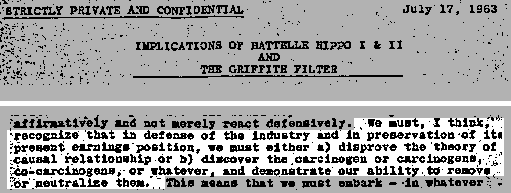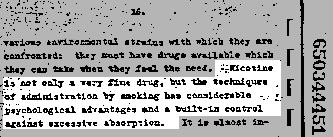Act I, Scene 2: Early Results - A Use for Nicotine

"We must, I think, recognize that in defense of the industry and in
preservation of its present earnings position, we must either a) disprove
the theory of causal relationship or b) discover the carcinogen or carcinogens...and
demonstrate our ability to remove or neutralize them."
Addison Yeaman, B&W counsel,
7/17/63 memo, 1802.05,p.1

"Nicotine is not only a very fine drug, but the technique of administration
through smoking has considerable psychological advantages and a built-in
control against excessive absorption."
Sir Charles Ellis at the
1962 Southampton Conference, 1102.01, p.19
Back at Brown & Williamson headquarters in Louisville, Kentucky, there
were high hopes that new filters, especially one being developed by B&W
researcher Dr. Robert Griffith, could clean up cigarette smoke. Meanwhile,
reports had come back from the Battelle lab which seemed to show nicotine
relieved stress without some of the nasty side effects of tranquilizers
("CONFIDENTIAL:
A Tentative Hypothesis on Nicotine Addiction," 1200.01
Excited by this news, Addison Yeaman, B&W's general counsel, fired off
a memo (Yeaman,
7/17/63 memo, 1802.05) expressing the hope that if tar could
be minimized and nicotine shown to be useful, a safe cigarette was within
reach. He also wanted to beat competitor Lorillard, whose Kent cigarettes
had a filter which some believed made their cigarettes safer. (It didn't.)
Within a few years, the quest for a safe cigarette led BAT to Ariel, a non-tobacco
product which provided nicotine but no smoke. But Ariel's nicotine kick
was just too overpowering. The project was quietly
abandoned.
The important thing about 1200.01
is that this is a very sophisticated hypothesis on the causes of nicotine
addiction - written more than 30 years ago. On p. 2 of the Yeaman memo,
Yeaman unabashedly says the TIRC "was conceived as a public relations
gesture." He advises, on p. 3, that the industry "steel itself"
and put a health warning on the pack. And he suggests something like "excessive
use of this product may be injurious to the health of susceptible persons."



|
|